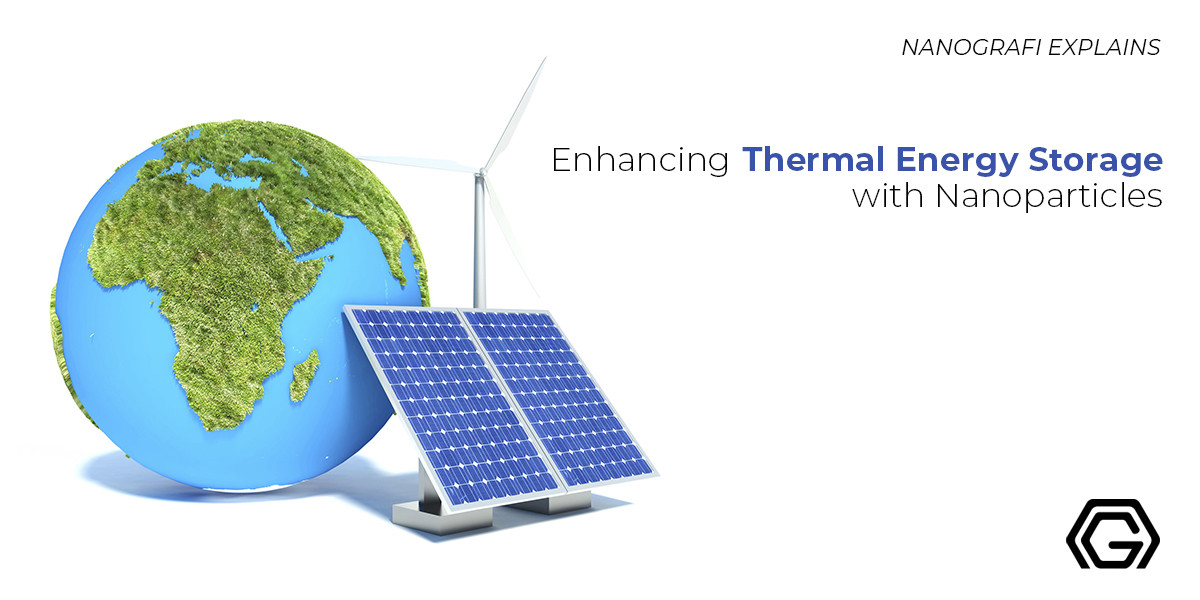Enhancing Thermal Energy Storage with Nanoparticles
Nanoparticles are those elements that are present on a nanometric scale which means it is below nm in either one of its dimension. They are known as nanoparticles because of the size that they hold which is equal to the size of a grain and has a very high fraction as well.
The natural production of nanoparticles is done by many geological, cosmological, meteorological, and biological processes. They have different properties but the most common one is their mobility. They are highly mobile in their free state. Nanoparticles have a wide range of processing and applications in enhancing thermal energy storage which is very much acknowledged in the industrial field.
Introduction
The ultrafine unit having measured dimensions is known as Nanoparticle, and they are measured in the nanometers. Naturally, in the world, nanoparticles exist and human activities lead to their creation. Nanoparticles have remarkable properties of material because of their submicroscopic size, and in many different areas, many practical applications are possessed by the manufactured nanoparticles, including environmental remediation, catalysis, engineering, and medicine. The classification of nanoparticles is done based on their different types, their shape, size, and characteristics of the material, if they are polymeric, ceramic, carbon-based, or semiconducting, or whether they are silica [silica dioxide] particles, and fullerenes), as soft (nanodroplets, vesicles, and liposomes), or as hard (titania [titanium dioxide]). There are a few classifications that differentiate between inorganic and organic nanoparticles. The method of nanoparticle production and the application of nanoparticles majorly determine how they are classified, for instance, in therapy or diagnosis versus basic research.
Properties of nanoparticles
Nanoparticles have 3 important physical characteristics, all linked with each other. In the free state, they are very mobile (without extra influence, the silica nanosphere’s 10 nm diameter has a rate of sedimentation of 0.01 mm/day under gravity in water. They also have huge specific surface areas, for instance, in comparison to a dozen double-sized tennis courts, a standard teaspoon, or about 6ml, of a silica nanospheres of 10-nm- diameter has more surface area. At the surface of each nanosphere, there are 20% of atoms. Quantum effects are exhibited by them. Therefore, nanoparticles have compositions in numerous ranges, based on the product or its usage.
How to enhance thermal energy storage with nanoparticles
During the time of demand, the storage of energy plays a very significant role in conserving the utilization of energy' over demand. Although, many kinds of energy sources like solar energy are intermittent in nature, for instance, dusty and cloudy weather affects solar energy, also, during the night, the non-availability. In this view, the thermal energy storages (TESs) perform important tasks in the recovery of heat and for the improvement of the thermal system's performance, TES contributes considerably as they are the simply contained mediums that in charging mode, are capable of storing the thermal energy and in discharging mode, are capable of releasing the thermal energy that’s stored for compensating the main thermal source’s shortage.
Usually, PCM (phase change material) or fluid is the storing medium. Generally, these materials that are based on TES have poor thermal conductivity, resulting in a slow rate of discharging and charging. Through the application of methods of enhanced heat transfer, the rate of discharging and charging can be improved. In this literature, various methods for enhancing the TES material's thermal conductivity are shown, ranging from bubble agitation, insertion of metal matrix and metal ring, extended fins and surfaces, encapsulation, and many others; nano additives are among them. Even for improving the base material’s properties, as the additives, nanomaterials are used.
When additives are mixed with the fluid, nanofluid denotes the produced mixture; meanwhile, when the addition of nanomaterials to the PCM happens, nanocomposites denote the production. Composites/nanofluids will denote them subsequently. For various applications of various nanomaterials, improvement in thermophysical characteristics was investigated and is also present in some published review articles. In various other articles, the emphasis is majorly on the technological applications and production methods in nanomaterial production.
Theoretically, numerically, and experimentally, the study on the characteristic mechanism improvement (convective and conductive heat transfer) has been done by these advanced materials. In this review, nanomaterials used as additives to the base storage materials for the improvement of TES have also been discussed. As a whole and development of heat exchanger, mostly TESs attention is with applications of cooling and heating. In cooling and heating processes, composites/nanofluid utilization in relation to various applications are discussed.

To get more information about MCMB for Li-Ion Batteries,
you can read our other blog post.
Applications of composites/nanofluids in the storage of thermal energy
With changes in the particles of nanoscale; the characteristics of bulk material also change as only one dimension is contained by the nanoparticles and that dimension measures in 100 nanometers or less. Partly, the changes of verse in the physio-chemical characteristics are because of the nanoparticle's kinetic movement at the layer of the surface. More surface area per weight is exhibited by them as compared to the larger particles which results in them having continuous random motion and being more reactive.
Nanoparticles dispersion in metals, polymers, fluids, and ceramics has opened more opportunities for more engineering of flexible composites which displays beneficial thermophysical characteristics. In many technological applications varying from transportation and biomedical to energy etc, these new hybrid composites/nanofluids are applied. The new area of research is the dispersion of nanoparticles for TES into the base fluids. Still, some nanoparticles that want to be dispersed into the base fluids for suiting specific applications for specific TES are under investigation. Now carbon nanotubes are the broadly used additives because their thermophysical characteristics are established and in comparison to other nanoparticles, their benefits have been proven. Different technologies combine to form TES, which stores thermal energy inside a reservoir to use it later. At periods of off-peak and peak, they can be used for balancing the demand for energy.
Applications of Cooling and heating are among the various technologies in TES, particularly with respect to buildings. For instance, in the statistical view, the total area of China's residential buildings is approximately 40 billion m2. The total national building energy consumption (TNBEC) is standard coal of 16 billion tons accounting for total end energy consumption of 20.7%. In the United States, 40% of all the energy is used by buildings. As compared to both transportation and industrial, more energy is consumed by this sector, surpassing industry in 1998 as the first consuming sector. Systems of cooling and heating are required by the electrical smart devices, microelectronics, transportation sector (Automobile), spacecraft, medical, and agriculture (livestock) for either thermal comfort or improving efficiency.
Heating and cooling of Buildings
In the industrial areas, the biggest scientific challenge is space cooling which is also implemented in various areas of production, including manufacturing, transportation, sporting arenas, microelectronics, etc. For many decades now, the cooling and heating of a space or building have traditionally been in practice. Amidst trees, the construction of buildings helps in cooling down the hot weather, and the brick usage in the building's walls for helping in cooling down the hot weather. TES effective utilization has resulted in the PCM usage in various building technologies for helping in heating and cooling, depending on the required comfort. In building applications, PCMs are for thermal storage because of their high latent heat storage capacity. PCMs low thermal conductivity brings a problem inadequate utilization, therefore the need of integrating the PCM with nanomaterials for improving the thermophysical characteristics is the latest development.
In building applications, the probability of the usage and development of PCM nanocomposites for improving the capacity of TES has been seen in numerous pieces of literature. The PCM enhanced nanocomposite's application in spaces or buildings majorly focuses on the usage of natural heat which is solar radiation, in hot weather for cooling and in the cold weather for heating through the usage of man-made cold or heat sources. Anyways, thermal energy storage is significant in matching the demand and the availability with respect to power and also with respect to time.
Cooling and Heating of Electrical and Electronic Components
The requirement of an effective dissipation mechanism is highly increased because of the technological enhancement in smart materials and components’ development for reducing the size and weight of electromechanical devices, specifically on the brighter optical devices and microelectronic devices, operating at higher power engines and high speeds. It has led to higher thermal loads that need improvements in cooling. The dissipation of heat is a factor in widening the available area for heat exchange and good conductive fluid usage. Although, without any intention, this method causes an increase in the thermal network system's size, therefore the requirement for novel coolants with enhanced performance is raised.
Oscillatory heating pipes, microchannels, and heat sinks are used for lessening the heat dissipated in a compact microelectronic device that is integrated with microelectromechanical systems (MEMs). For heat dissipation's conventional methods, micro-channels are a great alternative due to their very high rates of heat transfer, especially in the applications that are related to microelectronics cooling. Results were compiled and analyzed by the researchers from investigations on heat transfer and fluid flow in micro-tubes, and mini- and micro-channels. The great technical challenge in the electronic industry is the enhancement of the cooling system's thermal performance with the lessening in their desired surface area. A more efficient system of heat dissipation is being searched because of the microprocessors and other electronic equipment's continuous increase in power.
Recently and in the past, various methods have been studied in the usage of nano additives incorporated with conventional heat transfer fluids. The reported works on the usage of composites/nanofluids in computers and electronics for microelectronic device's cooling and heating applications, integrated with micro-electromechanical systems (MEMS) for the system of heat dissipated and heat transfer. Mostly, metals and metal oxide nanoparticles are implemented to base materials as nano additives.
Automobile Applications
Another source of storage for automobiles is the radiant energy falling through the windows inside the car during the daytime, specifically at the time of high solar intensity. Different ways have been used for storing and using this kind of energy so far when needed. This waste heat's effective TES can be used in preheating of the catalytic converter and the engine, defrosting the windows of the car, and cooling and heating the passenger compartment. Due to incomplete combustion, a vast amount of energy is lost in automobile engines, and gasoline is also consumed in huge amounts, thus contributing to the pollution of the environment.
Conclusion
Nanoparticles are famous in numerous fields of life as, despite their small size, they have unique excellent properties. Nanoparticles are used almost in every field but in the improvement of thermal energy storage, it's used best. Thermal energy storage is very significant and to assure its accurate working at a greater scale, they are being used via various methods and means.
To get more information, you can visit Blografi.
References:
https://www.researchgate.net/publication/263611270_Review_on_Nanomaterials_for_Thermal_Energy_Storage_Technologies
https://www.sciencedirect.com/science/article/pii/S2214785320314371
https://www.britannica.com/science/nanoparticle
Recent Posts
-
Advanced Materials for Unmanned Aerial Vehicle (UAV) Protection Against Laser
Consider a UAV on a critical mission, rendered inoperative by a sudden laser attack. With the increa …26th Jul 2024 -
Simulation and Modeling of Material Properties
Our world is composed of a dazzling array of materials, each with its own unique properties that dic …19th Jul 2024 -
Advanced Coatings for Superior Corrosion and Wear Resistance
Corrosion and wear pose significant challenges across various industries, leading to substantial eco …12th Jul 2024






